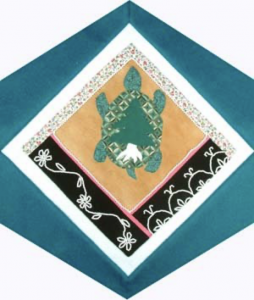Oneida

The Block
Marilyn Cornelius created the Oneida block with the help of her two nieces: artist Rosalind Antone, who designed the piece, and Tonya Lyn Antone, who helped with the beadwork. For the centrepiece, Rosalind chose a turtle appliquéd on leather to represent North America, known as Turtle Island among Native peoples. The white pine on the turtle’s back is the great Tree of Peace, which plays an important role in Oneida teachings. The calico border is typical of the colourful fabrics used to make dress shirts for men and dresses for women. The lower border is symbolic of the plant life that is so important to the people.
Cultural Profile
The Oneida call themselves Onyota’a:ka, which means “People of the Standing Stone.” The name refers to a large rock, placed in each Oneida village, that is used as a gathering place for ceremonial activities. Their traditional territory was in what is now New York State, but today there are Oneida communities located in Central New York, Wisconsin, and Ontario. The Oneida of the Thames live near London, Ontario on the Oneida Settlement. This tract of land (5,400 acres) was purchased in 1840 by a group of Oneida who pooled their resources, after receiving assurances from the British Crown that they would be protected and treated with respect. Today, the Oneida Settlement has a thriving agricultural and business community.
The Oneida are one of the original Five Nations to join the Haudenosaunee Confederacy (also known as the Iroquois Confederacy). The Confederacy, which was established in the 15th century, provided mutual protection for all members. Within it, the Oneida are known as the Younger Brothers. They are organized into three clans: Turtle, Bear, and Wolf.
Women were highly valued and respected in Oneida culture. Traditionally, clan lineage is traced through the mother’s line, and the politics of the nation have, for a long time, been strongly influenced by female opinion. Female leaders from each clan are the faith-keepers and spiritual advisors.
The American Revolutionary War caused significant devastation and tremendous change to the Oneida lifestyle. The continuous influx of European immigrants negatively affected traditional hunting grounds–making it difficult for the Oneida to find food–and also influenced their horticultural practices and customs. Traditional culture has remained a part of Oneida identity, passed on by the elders through their oral histories. A contemporary revival of the Oneida language and Longhouse seasonal celebrations is in full swing.
Sponsor: Elena Cincik-Mirga & Vojtech Mirga
